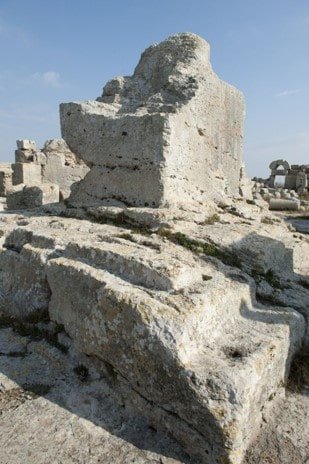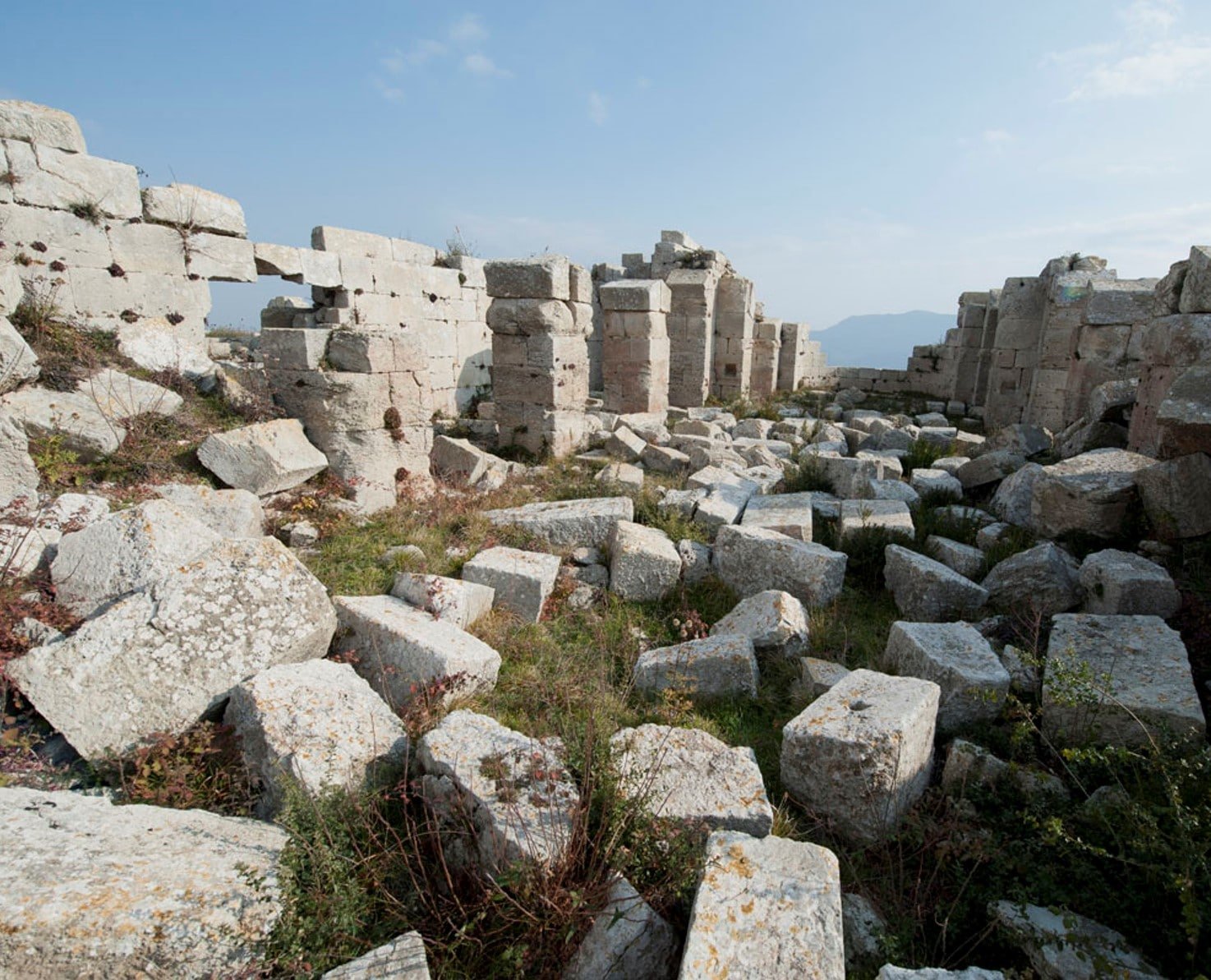The Monastery of Saint Simeon Stylites The Younger
per person
The Monastery of Saint Simeon Stylites the Younger (Turkish: Aziz Simon manastır) lies on a hill roughly 29 kilometers southwest of Antakya and 6 kilometers to the east of Samandağ, in the southernmost Turkish province of Hatay. This was said to stand on the «miraculous mountain», possibly because it was near Mt. Cassius which was a pagan holy mountain. Even today there is an Alawite shrine further down the mountain from the ruins of the monastery. Simeon the Younger was a sixth-century imitator of his fifth-century namesake, Simeon the Elder, and both of them were “pillar saint”.
A complex of buildings appears to have sprung up around Simeon the Younger’s pillar even during his lifetime. In his vita there is mention of Georgian followers settling at the site and later on they appear to have run their own monastery-within-a-monastery at the site (Emma Loosley, “Semandağ,” Architecture and Asceticism, 1997). The monastery of Saint Simeon was destroyed by Sultan Baybars during his campaign against Antioch in 1268 and never recovered (Noble, Samuel, and Alexander Treiger. The Orthodox Church in the Arab World, 700–1700: An Anthology of Sources. NIU Series in Orthodox Christian Studies. Cornell University Press, 2014: 32)
FORMAL ANALYSIS
The Monastery of Saint Simeon Stylites the Younger is a masonry building with some rock-cut sections, it has a cruciform plant settled on a rectangular measuring 132×160 m. It is encircled by two walls that are parallel to each other, in which currently two entrances, of the original three, are still preserved. The eastern section hosts three adjacent basilicas. The richly ornamented central church is dedicated to the Holy Trinity and can be considered as the main church of the site due to its direct relationship with the saint’s column. To the north is another more basic church, probably used by monks, that might have functioned in relationship to a baptistery, freestanding further to the north. To the south is the martyrion-church, containing the remnants of mosaics, which has a plan that can be defined as a basilica, yet is defined by the triconch arrangement at its eastern end. This last church is dedicated to Martha, mother of St. Simeon. In an octagonal courtyard, facing the Holy Trinity Church, the rock-cut base of the pillar on which Simeon lived can still be seen.
The first construction phase lasted ten years from 541 to 551, when the rectangular core, the atrium and the baptistery are erected. However, the martyrion church of St. Martha and the tetraconch located at the southwest corner of the octagon are added after the death of St. Martha in 562. The building complex has been transformed into a monastery by the very beginning of the 11th century, when the external western walls were probably built (https://pbase.com/dosseman/image/141351877).
VIRGINIA SOMELLA
- MONASTERY OF SAINT SIMEON STYLITES THE YOUNGER © PLAN AND SUGGESTED RECONSTRUCTION: https://pbase.com/ dosseman/image/141351877
- MONASTERY OF SAINT SIMEON STYLITES THE YOUNGER © PHOT. MAARTEN SEPP, WIKIPEDIA
- SIMEON STYLITES THE YOUNGER MONASTERY, CHURCH OF THE HOLY TRINITY. APSE OF THE CHURCH AND CAPITALS © PHOT. Dick Osseman, 2011, https://pbase.com/dosseman/image/141284601
- SIMEON STYLITES THE YOUNGER MONASTERY, CHURCH OF THE HOLY TRINITY. ENTRANCE TO THE CHURCH, VIEW OF THE PILLAR BASE © PHOT. Dick Osseman, 2011, https://pbase.com/dosseman/image/141284601
- SIMEON STYLITES THE YOUNGER MONASTERY, DETAILS OF THE CAPITALS IN THE CHURCH OF THE HOLY TRINITY © PHOT. Dick Osseman, 2011, https://pbase.com/dosseman/image/141284601
- SIMEON STYLITES THE YOUNGER MONASTERY, DETAILS OF THE CAPITALS IN THE CHURCH OF THE HOLY TRINITY © PHOT. Dick Osseman, 2011, https://pbase.com/dosseman/image/141284601
- SIMEON STYLITES THE YOUNGER MONASTERY, DETAILS OF THE CAPITALS IN THE CHURCH OF THE HOLY TRINITY © PHOT. Dick Osseman, 2011, https://pbase.com/dosseman/image/141284601
- SIMEON STYLITES THE YOUNGER MONASTERY, DETAILS OF THE CAPITALS IN THE CHURCH OF THE HOLY TRINITY © PHOT. Dick Osseman, 2011, https://pbase.com/dosseman/image/141284601
- SIMEON STYLITES THE YOUNGER MONASTERY, THE COLUMN OF THE SAINT AT THE HEART OF AN OCTOGONAL COURTYARD © PHOT. Dick Osseman, 2011, https://pbase.com/dosseman/image/141284601
- SIMEON STYLITES THE YOUNGER MONASTERY, THE COLUMN OF THE SAINT AT THE HEART OF AN OCTOGONAL COURTYARD © PHOT. Dick Osseman, 2011, https://pbase.com/dosseman/image/141284601
- SIMEON STYLITES THE YOUNGER MONASTERY. ROCK-CUT BASE OF THE COLUMN OF THE SAINT © PHOT. Dick Osseman, 2011, https://pbase.com/dosseman/image/141284601
- SIMEON STYLITES THE YOUNGER MONASTERY. THE FIRST STEPS OF A STAIRCASE ENABLING VISITORS TO CONVERSE WITH THE SAINT ON HIS COLUMN. IT WAS ACCESIBLE LEAVING THE MARTYRION OF MARTHA (SOUTH CHURCH), THEN TURNING TO THE RIGHT AND ENTERING THE OCTAGON) © PHOT. Dick Osseman, 2011, https://pbase.com/dosseman/image/141284601
- SIMEON STYLITES THE YOUNGER MONASTERY. SOUTH CHURCH / MARTYRION OF MARTHA, VIEW FROM WEST TOWARD THE APSE) © PHOT. Dick Osseman, 2011, https://pbase.com/dosseman/image/141284601
- SIMEON STYLITES THE YOUNGER MONASTERY. SOUTH CHURCH / MARTYRION OF MARTHA, VIEW FROM WEST TOWARD THE APSE) © PHOT. Dick Osseman, 2011, https://pbase.com/dosseman/image/141284601
- SIMEON STYLITES THE YOUNGER MONASTERY. SOUTH CHURCH / MARTYRION OF MARTHA, TWO NICHES TO THE LEFT AND RIGHT OF THE APSE) © PHOT. Dick Osseman, 2011, https://pbase.com/dosseman/image/141284601
- SIMEON STYLITES THE YOUNGER MONASTERY. SOUTH CHURCH / MARTYRION OF MARTHA, TWO NICHES TO THE LEFT AND RIGHT OF THE APSE) © PHOT. Dick Osseman, 2011, https://pbase.com/dosseman/image/141284601
- SIMEON STYLITES THE YOUNGER MONASTERY. NORTH CHURCH. VIEW FROM WEST TOWARD THE APSE © PHOT. Dick Osseman, 2011, https://pbase.com/dosseman/image/141284601
- SIMEON STYLITES THE YOUNGER MONASTERY. NORTH CHURCH. DETAIL OF THE MOSAIC FLOOR, COVERED BY EARTH AND DEBRIS © PHOT. Dick Osseman, 2011, https://pbase.com/dosseman/image/141284601
- SIMEON STYLITES THE YOUNGER MONASTERY. REMAINS OF CHURCH OF THE HOLY TRINITY) © PHOT. Dick Osseman, 2011, https://pbase.com/dosseman/image/141284601
- SIMEON STYLITES THE YOUNGER MONASTERY. REMAINS OF THE TETRACONCH) © PHOYS. Dick Osseman, 2011, https://pbase.com/dosseman/image/141284601
- SIMEON STYLITES THE YOUNGER MONASTERY. VIEW ALONG THE SOUTH WALL OF A CHURCH FLANKING THE MAIN ONE, AT THE SOUTH SIDE, THE MARTYRION OF MARTHA (SOUTH CHURCH) © PHOT. Dick Osseman, 2011, https://pbase.com/dosseman/image/141284601
- SIMEON STYLITES THE YOUNGER MONASTERY. VIEW OF THE SOUTHEASTERN CORNER OF THE COMPLEX, WITHIN THE WIDER PRECINT OF THE MONASTERY © PHOT. Dick Osseman, 2011, https://pbase.com/dosseman/image/141284601
- SIMEON STYLITES THE YOUNGER MONASTERY, VIEW FROM THE OCTAGON TOWARDS WEST © PHOT. FROM THE MUSEUM BROCHURE https://muze.gov.tr/muze-detay?SectionId=HSM01&DistId=MRK
Información de la localidad
The Monastery of Saint Simeon Stylites The Younger
| Other monuments and places to visit | Vespasianus Titus Tunnel, ancient water tunnel built in the 1st century AD within the boundaries of Seleucia Pieria, N-W of the monastery (46 min by car); Antioch archaeological site, N-E of the monastery (50 min by car). |
| Natural Heritage | Hills nearby Jebel Aqra. |
| Historical Recreations | |
| Festivals of Tourist Interest | |
| Fairs | |
| Tourist Office | Yes. |
| Specialized Guides | |
| Guided visits | |
| Accommodations | Accommodations in the city of Antakya (Antioch). |
| Restaurants | Restaurants in the town of Samandağ, or in the city of Antakya (Antioch). |
| Craft | |
| Bibliography | Glynias, Joe. ‘Byzantine Monasticism on the Black Mountain West of Antioch in the 10th-11th Centuries’. Studies in Late Antiquity 4, no. 4 (1 November 2020): 408–51. |
| Videos | |
| Website |
| Monument or place to visit | Monastery of Saint Simeon Stylites the Younger |
| Style | Remains of Late Antique local masonry structures, later medieval addictions. |
| Type | Monastic complex. |
| Epoch | 5th century – 1453. |
| State of conservation | Abandoned. Partially collapsed and vandalised with spray-paint. |
| Degree of legal protection | |
| Mailing address | Yeşilyazı, Yolu, 31800 Samandağ/Hatay, TR. |
| Coordinates GPS | 36° 5'28.69N 36° 2'7.89E |
| Property, dependency | |
| Possibility of visits by the general public or only specialists | Open to general public. |
| Conservation needs | “After necessary safety measures is in place, an architectural and condition survey needs to be undertaken in order to address possible solutions to the current structural problems. This monastery should be included in a cultural considered for inclusion in a cultural route together with the other rock-carved structures around it and the important monastery of Mor Yaʿqub, which is a tourist attraction” (Keser Kayaalp, 2022: 39). |
| Visiting hours and conditions | Opening time: 8:00am. Closing time: 7:00pm (box office closing time: 6:30pm). The ruins of the monastery complex are extensive, and to visit the entire site it will take a consistent amount of time. |
| Ticket amount | Free entry. |
| Research work in progress | |
| Accessibility | The top of the hill cannot be reached by public transport. However there are various possibility to get to the site. Hiking from the town of Uzunbağ (on the itinerary of the minibus line from Antakya to Samandağ), for a route uphill of 7km; by car, along the route D420 from Antakya to Samandağ; or by taxy from Samandağ. |
| Signaling if it is registered on the route | Not registered yet. |
| Bibliography | Emma Loosley, “Semandağ,” Architecture and Asceticism, 1997 (architectureandasceticism.exeter.ac.uk) Parker, Lucy. Symeon Stylites the Younger and Late Antique Antioch: From Hagiography to History. Oxford University Press, 2022. |
| Videos | |
| Information websites | muze.gov.tr wikipedia.org turkisharchaeonews.net pbase.com |
| Location | Located on top of a mount between Antakya(Antioch)-Samandağı Road and Asi River. |










































